This generation of gaming has been devoid of a true on the pitch alternative to Soccer or Association Football. To be fair, when behemoths such as EA‘s FIFA series and Konami‘s Pro Evolution series exist, it’s hard to want to make another game in that space. EA gave it a shot several times themselves with the FIFA Street series, with the last one coming to Xbox 360 and PlayStation 3 in 2012. Honestly though, you really have to go back even further to Mario Strikers Charged on the Nintendo Wii to find something that’s akin to a crazy arcade round ball experience.
Tamsoft and Bandai Namco‘s Captain Tsubasa: Rise of New Champions is actually a nice hybrid of both worlds. Marrying the presentation and pageantry of the game you would typically see in a FIFA title with the over-the-top gameplay of an arcade game. However, it also provides its own flavor of animation, expansive storytelling, and goalscoring that sets it apart from other games for better and for worse.
Review: Captain Tsubasa: Rise of New Champions
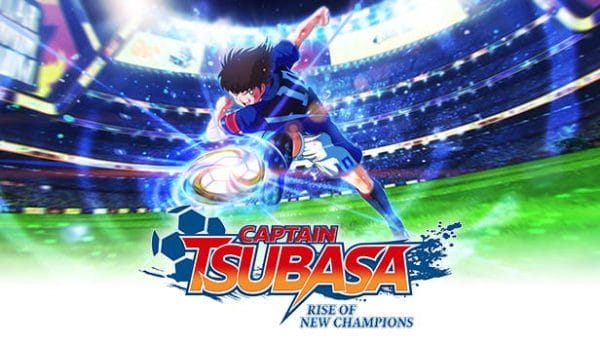
Title: Captain Tsubasa: Rise of New Champions
Platform: Nintendo Switch [Reviewed], PlayStation 4, Xbox One, PC,
Developer: Tamsoft
Publisher: Bandai Namco Entertainment
Genre: Arcade Soccer
Players: 1-4
Release Date: August 28, 2020
Price $59.99 (USD)
Anime Origins
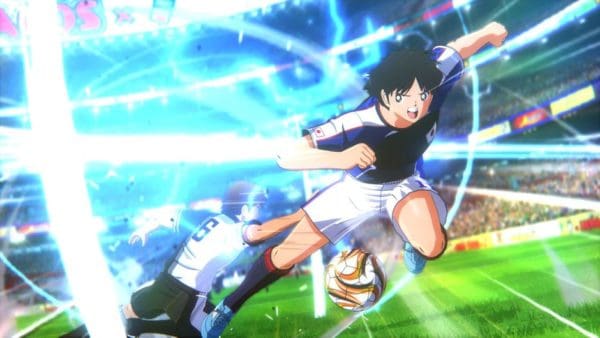
Captain Tsubasa: Rise of New Champions is based on the Manga series Captain Tsubasa which was created by Yoichi Takahashi in 1981. Not too long after that, the first Captain Tsubasa anime came out in 1983 and lasted for three years ending in 1986. Since then, many Original Video Animation films, sequel anime series, and video games have released. However, most of the series’ spinoff media has not seen a major release outside of Japan. None of the various anime series can be found on one of the popular streaming services, so if you want to see what inspired many in Japan and even major soccer players worldwide to love the beautiful game you have to use Youtube or other less fashionable places.
Focusing on the gaming side of things, in general, releases are extremely scattershot. Its first game was actually renamed Tecmo Cup Soccer (1992) in many regions to give it more broad appeal. Captain Tsubasa continued getting more games in the early to mid-1990s, but there’s a big gap of nothing until 2002. This also coincides with the 2002 FIFA World Cup co-hosted by Japan and South Korea. The last proper major console game released was in 2006 (also a World Cup year), on the PlayStation 2. After that, in 2010 (once again a World Cup year,) there was the Nintendo DS game Captain Tsubasa: Gekito no Kiseki and that’s pretty much it for the traditional fare.
Firmly in the Now
However, 2017-2018 saw a resurgence for the franchise with a few mobile games and a reboot anime that lasted for 52 episodes. This anime, simply named Captain Tsubasa runs through the elementary school and middle school arcs of the Captain Tsubasa Manga. It is also the major driving force behind Captain Tsubasa: Rise of New Champions, as the game’s two campaign modes use story arcs, characters, and major set pieces from the Middle school portion of said anime. Even going as far as unlocking these important moments of the anime for you to view as a video collection, as you progress through the story mode, weirdly yet also appropriately named The Journey.
Tsubasa is Magical

The shorter of the two campaign modes, Episode: Tsubasa, serves a double function. It is in essence an introduction to the series’ main character, Tsubasa Ozora. Considering Tsubasa literally has his life saved by a soccer ball as a child. It is hardly surprising that he has a natural and exuberant love for the game. This gives him a passion for soccer that subsequently pushes him into becoming Japan’s great hope at one day winning a World Cup. Before that though, his major focus is wanting to become a three-time consecutive champion with his teammates at Nankatsu SC. Throughout the story, you’ll meet star players from other teams and even former teammates of Tsubasa’s who are now at rival clubs. Who all want to have their shot at dethroning Japan’s best young star.
Along the way, you’ll also experience a tutorial of sorts and learn about super shots, one-two passing, and dazzling dribbles. These moves help you defeat Tsubasa’s major foes and experience his triumphs and tribulations. Although he does suffer some in-game setbacks and injuries, the story here is fairly straightforward. Win every match, even if it means going to a penalty shootout. Thus making his sworn enemies into his biggest fans by the end. Ultimately, this feels like an obligated anime tie-in. Easily satisfying anyone that just wanted to play as their hero. While also getting you ready for the much grander experience that follows.
Creating a Journey
Episode: New Hero, is a much longer and expansive mode in several ways. Here, you create a character and choose one of three rival clubs. Then, you join the team and experience what happens a year after the events of Episode: Tsubasa. From a gameplay perspective, this is more akin to the first few years of the FIFA career mode. The focus is sort of on your character, you can level up his stats, and you unlock skills and special moves while playing. There’s also a friend system that allows you to level up with certain players. Thus giving your created character the ability to learn their moves.
However, the story itself is still majorly focused on the captain of the team you choose. For example, in my playthrough, I choose Furano FC, and the story mostly revolved around my character and the team’s care for captain Hikaru Matsuyama.
This is also mirrored on the pitch where you are not forced to play as your character for the entire match. And although he does have his own rating depending on how you use him, the team’s rating is even more important in bringing you individual success. For instance, a high team rating during a match helps in leveling up the entire team. Thus granting you 350 points to level up your player. While an individual high rating only helps in the friend system, gaining certain moves and maxes out at about 50 points per match.
Sometimes There’s Just Too Much
When not on the pitch, the story plays out in cutscenes. Many of them do give your character dialogue options, albeit mainly with just slight variations. Overall, as someone that has watched very little of the source material, but does enjoy soccer and anime as a whole, I felt it tells an enjoyable story with an ending that satisfies, but also leaves things open because these youngsters haven’t even hit high school yet. Episode: New Hero actually does try to build the narrative around other characters on other teams. Giving you some modicum of reason to care about them.
The problem is, it takes a long time to get to those instances. Especially during the in-between periods of matches where you are just wanting to get to the next one. Some of the sections make total sense, such as scouting another team that’s playing in the same tournament. But perhaps there’s not a huge reason in watching the match unfold. This also happens during the half-time periods too. Getting a breakdown from the managers about the match is great. Having to hear from almost every player on the squad before getting to the second half is a tad annoying.
There are even some cutscenes that happen during a match depending on certain circumstances. Some of them actually lead to your team or the opposing team scoring goals. While others merely exist to show off some amazing shots, dribble moves, or saves. The issue is many of these instances are also disorienting and lead to missed opportunities. When you combine all of this together it ultimately just starts to feel supremely overwhelming. I truly do appreciate the narrative being told in Captain Tsubasa: Rise of New Champions. But at times I did feel that the story started venturing into visual novel lengths of extra diatribe.
The Crux of it All
I should note that all of these scenes are entirely skippable. So, if you get tired of the elongated narrative, you can just get to the important stuff. But much like an actual anime, pushing through the filler does grant you some fantastic moments. Perhaps it is merely a mileage may vary type situation. Although, the only way to export your created character for use in other portions of the game is to actually complete Episode: New Hero. So, you could actually export three different characters without having to use the same team again, but I wonder how many folks would actually play this mode more than once.
There’s Nothing Else Like It
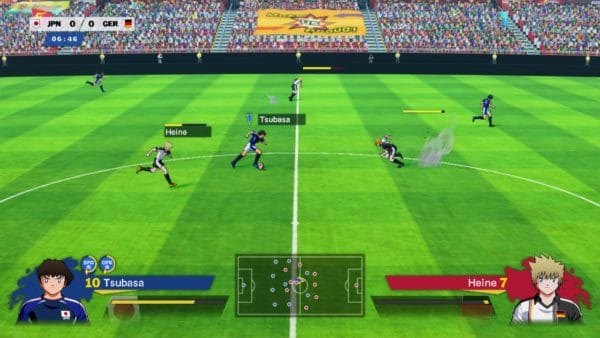
Captain Tsubasa: Rise of New Champions gameplay is certainly in a class of its own. Honestly, there’s nothing directly comparable to the major aspects of playing this sports title. Anyone that’s played a FIFA or PES game eventually adapts to a certain playstyle or has a group of favorite teams. While you can pass, cross, and try developing play from the back in Captain Tsubasa, it won’t get you very far. In fact, playing this way led to a lot of draws and penalty shootouts for me.
Being an arcade title, the first thing that’s readily apparent is how quickly the game becomes extremely rough and tumble. Knocking an opposing player over by barging into them is the easiest and quickest way to gain back control of the ball. There’s still the more elegant slide tackle, but it is much easier to dodge than just whacking someone from behind. Especially because driving a shoulder into a player also knocks them out for about 10 seconds as well. There are also defensive special moves that can offer last-ditch efforts when all hope is lost. Plus, there are also special moves that deflect and completely block shots too. These are things you have to get used to when playing both the A I and actual real opponents. Honestly, no other game has taken the phrase, “a battle in the midfield”, to more literal levels.
Tricking With the Best of Em
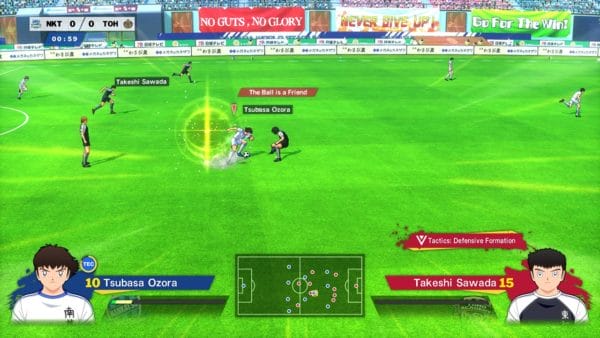
Another major point of gameplay is the tricks. I mean, it wouldn’t be an arcade game without them. Especially on higher difficulties, the only way to avoid losing the ball or getting around a key defender is by using a one-two pass or by some type of trick. This is also where you’ll really start to deal with the game’s stamina system. Stamina is required for basically every major thing in the game. From catching up to the screeching midfielder, taking a big shot, or even making saves. It all revolves around this system. For the most part, it really is not a hindrance. However, it is something you do have to manage at times.
The tricks are totally cool and many of the major characters have their own specific ones. Perhaps the only flaw is that the timing window for doing them is extremely tight. When you can actually pull off a few in a row it puts that player in a zone. Making any you perform after that a major spectacle. However, since defenders can also use super defensive moves, it is much more likely that you’ll see the awesome run of taking out three players end in the attacker splattered on the pitch by a nasty thumping tackle. So be ready for a lot of potentially cool moments to end a big whimper.
That’s Just Total Fire
If you’ve seen anything about Captain Tsubasa: Rise of New Champions at all, it’s probably one of the insane shots. There’s no doubt that the animation team spent a great deal of time making these super shots look incredible. Each major striker has their own unique shot that gels with the way they play. Watching some of them in action is truly amazing. The thing is, the special vibe these shots have is very short-lived. And although several of the big players have even more spectacular upgraded versions of these shots, forced repetition is sadly a necessary evil.
Fighting For Goals

Perhaps the most divisive gameplay aspect of Captain Tsubasa: Rise of New Champions is its goalscoring. It is almost quite laughable how an arcade title actually mirrors both the pain and joy of scoring a goal in the real game. There were a handful of times where I knew I was putting up a prayer only to watch it actually miraculously go in the net due to an AI error. Conversely, I also thought I had several sure-fire goals get turned away as well. However, the game features way more of the latter than the former.
This is due in large part because low scoring is a direct correlation of the goalscoring system. Unlike in other soccer games, where goalkeepers many times feel like afterthoughts, Captain Tsubasa makes them huge stars alongside the strikers and playmakers. Each goalkeeper has their own stamina bar that slowly whittles down the more you shoot at them.
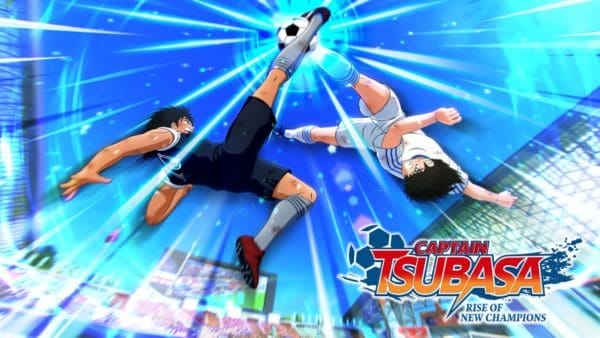
Unfortunately, there is a huge downside to using this type of system. Yes, it keeps games within reach and low scoring, but at the cost of actual fun. The only real chance you have of making any headway with a goalkeeper’s stamina bar is to spam the super shots constantly. So instead of trying to build up play and combine for a terrific team score. The game devolves into a shot fest and not really in an enjoyable way. It did not take long to figure out that the best way to play was to just take super shots from anywhere past midfield whenever I had enough space to be able to build-up the shot bar. So scoring goals almost amounts to taking down a health bar in an RPG boss battle.
Furthermore, unless you are playing in exhibition mode or online against an opponent that agrees to a match that’s longer than four minutes per half, the clock is also an enemy in this war as well. In singleplayer, all games are four minutes per half. So, you literally have a very small window of time to get off as many shots as possible before hitting half-time where a goalkeeper’s health bar is completely replenished. Then in the second half, it becomes more of the same. If you happen to be able to pull off a powerful close shot, you can knock out a good chunk of the health bar in one or two blasts, but the chances of that are very slim. Especially since it is much easier to dispossess an opposing player of the ball at the last moment than it is to actually get off a shot.
Get Into the V-Zone
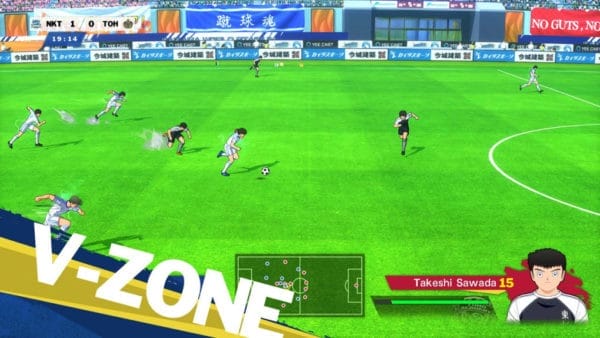
Thankfully, Captain Tsubasa: Rise of New Champions does have a trump card called the V-Zone. By doing tricks, special shots, and even stopping major plays on the defensive end you build up the V-Zone meter. Once it is complete, This essentially gives your entire team super strength and speed for an extended period of time. So players are faster, virtually lose no stamina, and can use extra special super moves. However, they are not invulnerable or “on fire” like say in NBA Jam. You can very much still lose possession of the ball.
So there’s a strategy of when to use this. You can wait until near the end of the half to gain a last-minute advantage. You could also play defense with it and wait until the AI uses their V-Zone to deploy your own. Also, special shots charge up considerably faster while this is in effect too. So, you could also use it as a way to unleash a barrage of offense. Lastly, goalkeepers all have a Super Save that is only available with a full V-Zone meter. Providing the ultimate ability to stop a shot that you feel could wind up going into the back of the net.
The Big Problem
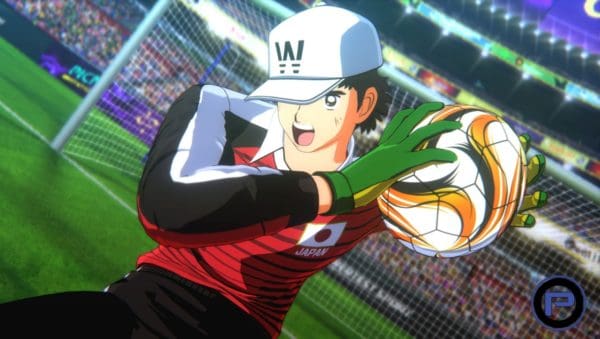
The thing is, none of this can offset the dreadful samey feeling I had with playing every match. Yes, I was always at the edge of my seat because I was always either tied, a goal ahead, or a goal behind. But I was doing pretty much the exact same thing each time. Get the ball to one of my forwards and find any opening I could to take a shot and see what happened. I should mention that when I mean find an opening, many times it was running around in a circle while holding the shot button down until the super shot icon lit up and then let it fly. Mainly because if you try to do too much you’ll more than likely lose possession. Not to mention, you can have your shots easily interrupted by defenders too. So it becomes a frustrating practice in attrition.
A lot of the enjoyment in Soccer is capitalizing on strategy. Finding a way to exploit a weakness or seeing how styles clash against each other. Captain Tsubasa: Rise of New Champions has virtually none of that. It whittles everything down to a simple concept, but perhaps one that is too simple. Out shoot your opponent. But basically, it is all you need to do. There is some tug of war, some fight, but the creativity of the beautiful game is gone.
Think about this, the only time it matters in what direction you to try shoot the ball is if you get in a penalty shootout. Otherwise, every shot you take, barring an AI error, will be initially stopped by the goalkeeper. Then, depending on where their health bar is, the keeper either blocks it or it magically goes through their hands and in the net. I’m not joking, what I just described NEVER changes.
At least when playing online it is much more of a battle than in singleplayer. So there’s more joy in playing against someone because both of you know what the deal is. So I found myself having to use tricks, one-two passes, volleys, and through passes for the element of surprise. But ultimately, the developer’s decision to force close games by limiting strategy destroys the enjoyment. Yes, you don’t get the crazy score fests of a Mario Strikers. You also don’t get the heavy pre-game management of a FIFA or PES. But this in-between of both styles is wonderful in the presentation. Not so great in gameplay execution.
Some Other Issues
I mentioned previously that the animation and presentation are fantastic. Quite frankly, Captain Tsubasa: Rise of New Champions animations and overall style are on par with almost anything out there. However, camera issues and technical hitches do encumber upon some of that. Firstly let me touch on the camera. In general, it does follow the action fairly well on offense. However, when the ball switches sides it has trouble widening out. So many times you have to manually move a defender that’s farther away from the ball into the action.
It doesn’t happen all the time, but it does happen a significant amount to be an issue. To be fair, since I played as a defender in high school and college I usually play as a defender in the created character career modes. So, this is something I had to deal with a lot more than perhaps someone that chooses to play as a midfielder or forward would.
Adding on to that, the game also has some issues with technical glitches. I’ve mentioned a few times about the AI goalkeeper errors. There are also several times where the super shot icon would activate but it winds up as a regular shot instead. These are both things I only encountered a handful of times over my entire playthrough. However, when scoring a goal has such slim margins these issues do get bothersome.
One More Thing
I did want to mention once again how amazing the game looks and plays. The ambiance of the stadiums, the electricity in the commentary, and its respect for not only its source material but also the sport really shine through. While all of the voiceover and commentary are in Japanese, I never found myself missing anything.
Another standout thing about the game is its soundtrack. The music sweeps and soars and is just pretty great to listen to on its own as well. You also get to unlock more of it as you keep playing. Then you can listen to it all inside the game itself. It would be nice if there was a bit more variety during actual gameplay, but that really comes down to personal preference.
This game was reviewed using a digital code provided by the publisher (Bandai Namco).
Final Thoughts
Overall, Captain Tsubasa: Rise of New Champions does a lot of things right. The presentation and passion for the anime and the sport are extremely evident. The soundtrack is fantastic as well. Both stories are well worth trudging through even if at times the New Hero one feels long. Although you could easily just call it the typical anime sports fare, there are quite a few grand moments in both singleplayer modes. Sadly, the repetition and lack of strategy in the gameplay holds the game back from being a standout title. As a package for fans of Captain Tsubasa, it delivers in almost every aspect. Unfortunately, the one place where it quite just doesn’t hit home is the most important one.
